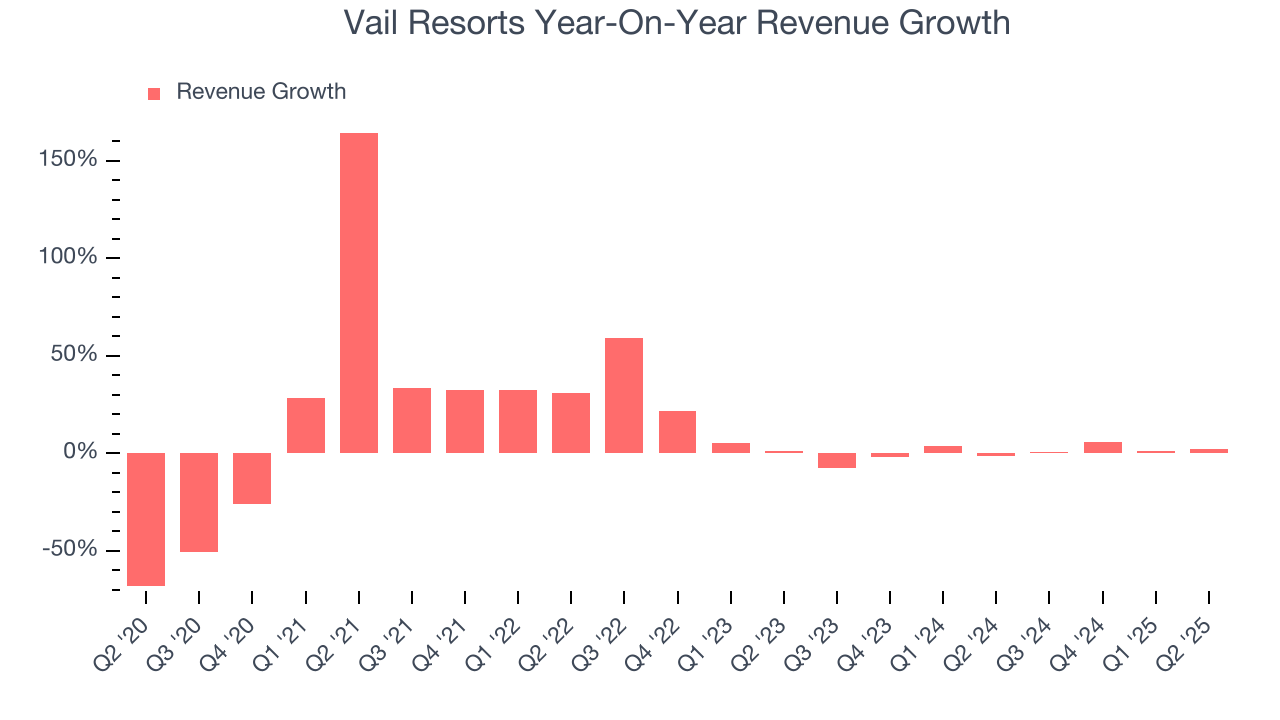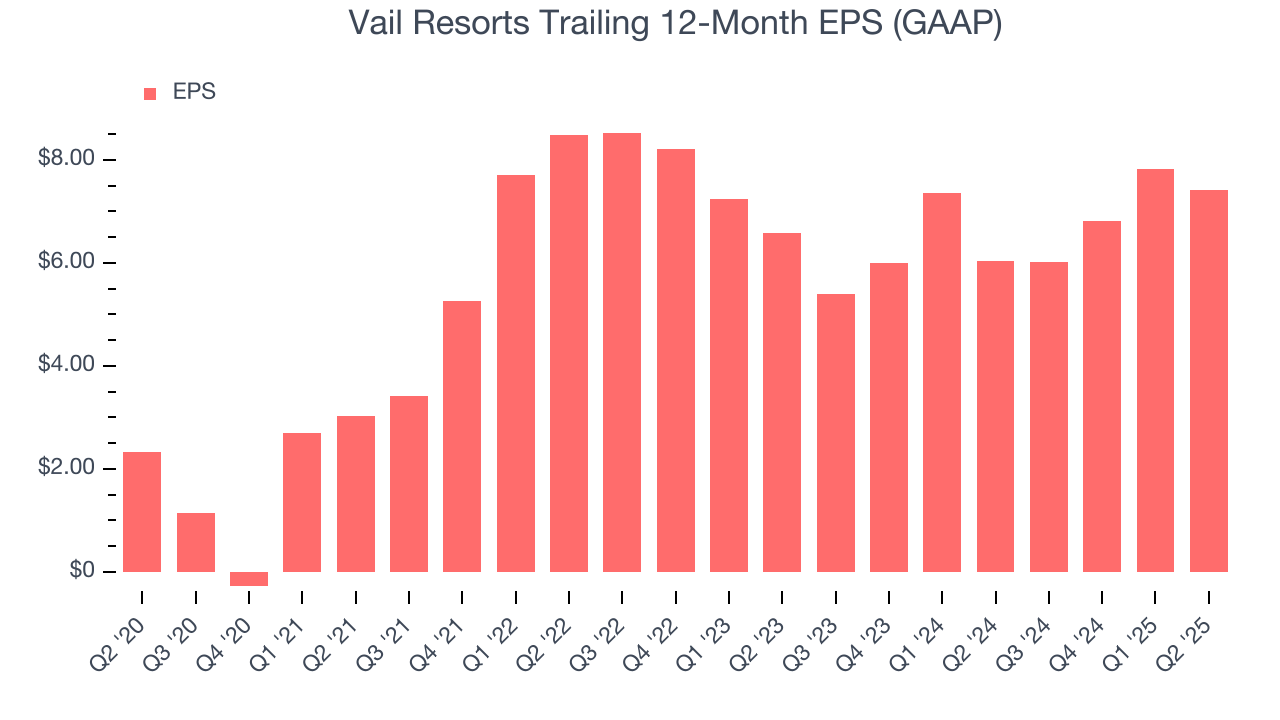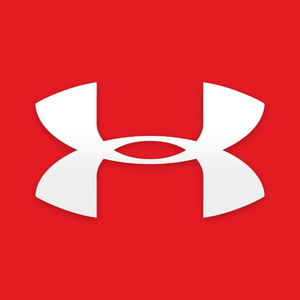
Vail Resorts (MTN)
Vail Resorts is in for a bumpy ride. Its weak sales growth and low returns on capital show it struggled to generate demand and profits.― StockStory Analyst Team
1. News
2. Summary
Why We Think Vail Resorts Will Underperform
Founded by two Aspen, Colorado ski patrol guides, Vail Resorts (NYSE:MTN) is a mountain resort company offering luxury experiences in over 30 locations across the globe.
- Muted 8.6% annual revenue growth over the last five years shows its demand lagged behind its consumer discretionary peers
- Lacking free cash flow limits its freedom to invest in growth initiatives, execute share buybacks, or pay dividends
- ROIC of 15.6% reflects management’s challenges in identifying attractive investment opportunities


Vail Resorts falls below our quality standards. There are better opportunities in the market.
Why There Are Better Opportunities Than Vail Resorts
High Quality
Investable
Underperform
Why There Are Better Opportunities Than Vail Resorts
Vail Resorts is trading at $140.69 per share, or 20.7x forward P/E. This valuation is fair for the quality you get, but we’re on the sidelines for now.
There are stocks out there similarly priced with better business quality. We prefer owning these.
3. Vail Resorts (MTN) Research Report: Q2 CY2025 Update
Luxury ski resort company Vail Resorts (NYSE:MTN) fell short of the market’s revenue expectations in Q2 CY2025 as sales rose 2.2% year on year to $271.3 million. Its GAAP loss of $5.08 per share was 7.7% below analysts’ consensus estimates.
Vail Resorts (MTN) Q2 CY2025 Highlights:
- Revenue: $271.3 million vs analyst estimates of $272.8 million (2.2% year-on-year growth, 0.5% miss)
- EPS (GAAP): -$5.08 vs analyst expectations of -$4.72 (7.7% miss)
- Adjusted EBITDA: -$124.8 million vs analyst estimates of -$125.3 million (-46% margin, in line)
- EBITDA guidance for the upcoming financial year 2026 is $875 million at the midpoint, below analyst estimates of $890.4 million
- Operating Margin: -75.1%, in line with the same quarter last year
- Skier Visits: 753,000, up 54,000 year on year
- Market Capitalization: $5.49 billion
Company Overview
Founded by two Aspen, Colorado ski patrol guides, Vail Resorts (NYSE:MTN) is a mountain resort company offering luxury experiences in over 30 locations across the globe.
Vail Resorts emerged from the vision of Pete Seibert and Earl Eaton. Inspired by the breathtaking beauty of the Colorado Rockies, they envisioned a world-class skiing destination that would cater to those seeking both adventure and luxury. The duo's dream, however, was not merely to introduce another ski destination, but to elevate the entire skiing experience.
While many resorts pride themselves on either their slopes or amenities, Vail Resorts has meticulously created a blend of both. The company uses advanced snowmaking systems to ensure optimal ski conditions and complements its slopes with fine dining experiences epitomizing alpine luxury. Beyond skiing, Vail introduces guests to a variety of cultural and recreational experiences to provide guests with memorable experiences regardless of the season.
Vail Resorts's business model leverages a combination of mountain operations, lodging, and real estate. Its diversified revenue streams include lift ticket sales, ski school services, dining, retail, and lodging sales.
4. Leisure Facilities
Leisure facilities companies often sell experiences rather than tangible products, and in the last decade-plus, consumers have slowly shifted their spending from "things" to "experiences". Leisure facilities seek to benefit but must innovate to do so because of the industry's high competition and capital intensity.
Competitors offering luxury ski resort experiences include Alterra Mountain Company and Boyne Resorts while companies offering cheaper leisure experiences include SeaWorld (NYSE:SEAS) and Six Flags (NYSE:SIX).
5. Revenue Growth
Examining a company’s long-term performance can provide clues about its quality. Any business can have short-term success, but a top-tier one grows for years. Over the last five years, Vail Resorts grew its sales at a sluggish 8.6% compounded annual growth rate. This fell short of our benchmark for the consumer discretionary sector and is a tough starting point for our analysis.

We at StockStory place the most emphasis on long-term growth, but within consumer discretionary, a stretched historical view may miss a company riding a successful new product or trend. Vail Resorts’s recent performance shows its demand has slowed as its annualized revenue growth of 1.3% over the last two years was below its five-year trend. Note that COVID hurt Vail Resorts’s business in 2020 and part of 2021, and it bounced back in a big way thereafter. 
Vail Resorts also discloses its number of skier visits, which reached 753,000 in the latest quarter. Over the last two years, Vail Resorts’s skier visits averaged 9.4% year-on-year declines. Because this number is lower than its revenue growth during the same period, we can see the company’s monetization has risen. 
This quarter, Vail Resorts’s revenue grew by 2.2% year on year to $271.3 million, falling short of Wall Street’s estimates.
Looking ahead, sell-side analysts expect revenue to grow 3.4% over the next 12 months. Although this projection indicates its newer products and services will fuel better top-line performance, it is still below average for the sector.
6. Operating Margin
Operating margin is an important measure of profitability as it shows the portion of revenue left after accounting for all core expenses – everything from the cost of goods sold to advertising and wages. It’s also useful for comparing profitability across companies with different levels of debt and tax rates because it excludes interest and taxes.
Vail Resorts’s operating margin has been trending up over the last 12 months and averaged 18% over the last two years. On top of that, its profitability was top-notch for a consumer discretionary business, showing it’s an well-run company with an efficient cost structure.

This quarter, Vail Resorts generated an operating margin profit margin of negative 75.1%, in line with the same quarter last year. This indicates the company’s overall cost structure has been relatively stable.
7. Earnings Per Share
We track the long-term change in earnings per share (EPS) for the same reason as long-term revenue growth. Compared to revenue, however, EPS highlights whether a company’s growth is profitable.
Vail Resorts’s EPS grew at an astounding 26.1% compounded annual growth rate over the last five years, higher than its 8.6% annualized revenue growth. This tells us the company became more profitable on a per-share basis as it expanded.

In Q2, Vail Resorts reported EPS of negative $5.08, down from negative $4.67 in the same quarter last year. This print missed analysts’ estimates, but we care more about long-term EPS growth than short-term movements. Over the next 12 months, Wall Street expects Vail Resorts’s full-year EPS of $7.41 to grow 2.9%.
8. Cash Is King
Free cash flow isn't a prominently featured metric in company financials and earnings releases, but we think it's telling because it accounts for all operating and capital expenses, making it tough to manipulate. Cash is king.
Vail Resorts has shown robust cash profitability, giving it an edge over its competitors and the ability to reinvest or return capital to investors. The company’s free cash flow margin averaged 16.5% over the last two years, quite impressive for a consumer discretionary business.

9. Return on Invested Capital (ROIC)
EPS and free cash flow tell us whether a company was profitable while growing its revenue. But was it capital-efficient? Enter ROIC, a metric showing how much operating profit a company generates relative to the money it has raised (debt and equity).
Vail Resorts historically did a mediocre job investing in profitable growth initiatives. Its five-year average ROIC was 14.4%, somewhat low compared to the best consumer discretionary companies that consistently pump out 25%+.
We like to invest in businesses with high returns, but the trend in a company’s ROIC is what often surprises the market and moves the stock price. Unfortunately, Vail Resorts’s ROIC has stayed the same over the last few years. If the company wants to become an investable business, it must improve its returns by generating more profitable growth.
10. Balance Sheet Assessment
Vail Resorts reported $440.3 million of cash and $3.19 billion of debt on its balance sheet in the most recent quarter. As investors in high-quality companies, we primarily focus on two things: 1) that a company’s debt level isn’t too high and 2) that its interest payments are not excessively burdening the business.

With $862.8 million of EBITDA over the last 12 months, we view Vail Resorts’s 3.2× net-debt-to-EBITDA ratio as safe. We also see its $163 million of annual interest expenses as appropriate. The company’s profits give it plenty of breathing room, allowing it to continue investing in growth initiatives.
11. Key Takeaways from Vail Resorts’s Q2 Results
We struggled to find many positives in these results. Its EPS missed and its . Overall, this was a weaker quarter. The stock traded down 1.4% to $146 immediately following the results.
12. Is Now The Time To Buy Vail Resorts?
Updated: December 4, 2025 at 10:02 PM EST
The latest quarterly earnings matters, sure, but we actually think longer-term fundamentals and valuation matter more. Investors should consider all these pieces before deciding whether or not to invest in Vail Resorts.
We see the value of companies helping consumers, but in the case of Vail Resorts, we’re out. First off, its revenue growth was weak over the last five years, and analysts expect its demand to deteriorate over the next 12 months. On top of that, Vail Resorts’s number of skier visits has disappointed, and its projected EPS for the next year is lacking.
Vail Resorts’s P/E ratio based on the next 12 months is 20.7x. While this valuation is fair, the upside isn’t great compared to the potential downside. There are better investments elsewhere.
Wall Street analysts have a consensus one-year price target of $173.73 on the company (compared to the current share price of $140.69).
Although the price target is bullish, readers should exercise caution because analysts tend to be overly optimistic. The firms they work for, often big banks, have relationships with companies that extend into fundraising, M&A advisory, and other rewarding business lines. As a result, they typically hesitate to say bad things for fear they will lose out. We at StockStory do not suffer from such conflicts of interest, so we’ll always tell it like it is.











